
How Building Professionals Use Social Media for Business
Overview: What building product manufacturers should know!
Businesses have always utilized new technologies to enhance their performance and output. And social media in its many forms — blogs, forums, business networks, photo-sharing platforms, social gaming, microblogs, chat apps, and social networks — has emerged as such a technology and worked its way into business consciousness.
The latest data from DataReportal[1] shows that there are 4.48 billion social media users around the world as of July 2021. That is almost twice as many as there were just five years ago. The biggest surge of users was in the past 12 months (during the pandemic) with 520 million new users joining social media in the year to July 2021.In all, that’s about 70% of the viable population.
Social media was once mostly just for fun or for staying in touch with friends and family; but not anymore. As a business tactic for enhancing performance, manufacturers have come to utilize these channels for communicating with their customers.
Clearly, social media for business is no longer optional. It’s an essential way to reach customers, gain valuable insights, and grow a brand. So, the real question is: How can manufacturers harness social media and use it to communicate and share information with building professionals?
It all begins with an understanding of how professionals involved with building construction use social media.
Although the lines between using social media for personal or business use are often blurred, Accountability Information Management, Inc. (AIM) research has cleared a path with a focus on how professionals use social media for business. This white paper discusses which building professionals use social media, how they use it, how often they use it and where it might differ based on the type of professional or their age. The objective is to provide a clear line of sight to reach and engage building professionals on social media.
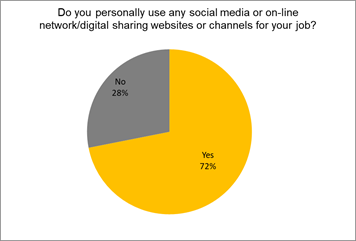 Who is Using Social Media?
Who is Using Social Media?
Prior to the pandemic, the building construction industry was very hesitant to fully embrace social media. The building industry was not unique in this hesitation. In fact, according to a 2021 study conducted by the Rain Group of professionals involved in selling across the US, only 21% pre-pandemic were using virtual selling tools. During/post COVID-19, however, 71% were actively using virtual tools for selling their products. [2]
While the use of social media/online media channels may not be for everyone, the AIM research indicates most building professionals, such as architects, designers, engineers and facility managers, are in fact using it for their jobs (72%). When the COVID-19 pandemic hit, many building professionals found social media and online media channels a great way to stay “connected” to the market. They also learned it was a way to look for trends in the industry and see what other professionals are up to.
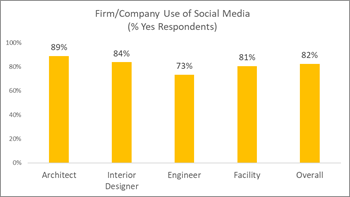 While the majority of building professionals are using social media for their jobs, the companies they work for are also using it. In fact, the AIM research indicates building professionals’ companies are more likely to use it with 82% indicating their companies are using social media. It seems obvious now that all building design companies are actively using social media. The activity seems to correlate with the individual professional using it as well.
While the majority of building professionals are using social media for their jobs, the companies they work for are also using it. In fact, the AIM research indicates building professionals’ companies are more likely to use it with 82% indicating their companies are using social media. It seems obvious now that all building design companies are actively using social media. The activity seems to correlate with the individual professional using it as well.
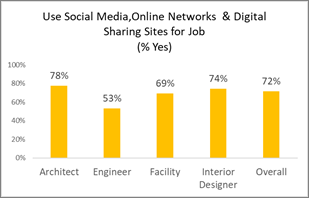 For example, architects and their companies are the top users, followed by designers, facilities and engineers. respectively. These are measuring well over 80% for the most part, except engineering companies who seem to use it less. Most companies, for example, have direct links to their social media channels from their websites. Whether or not they measure, the traffic is not known. However, those that AIM measures show traffic patterns that while not very high, nevertheless create a “connection point” to the company for people who want to travel that channel. The connection point, it turns out, is one of the secrets of successful companies.
For example, architects and their companies are the top users, followed by designers, facilities and engineers. respectively. These are measuring well over 80% for the most part, except engineering companies who seem to use it less. Most companies, for example, have direct links to their social media channels from their websites. Whether or not they measure, the traffic is not known. However, those that AIM measures show traffic patterns that while not very high, nevertheless create a “connection point” to the company for people who want to travel that channel. The connection point, it turns out, is one of the secrets of successful companies.
According to a December 2021 article published by Architect[3] magazine, online channels are influencing architects in many ways and but can also cause issues for architects when negative or incorrect information gets posted. While many architects use social media to showcase their projects and work or develop their business, the article pointed out that some architects are finding it helps them educate their audience and find a voice in the industry for influencing change or social good.
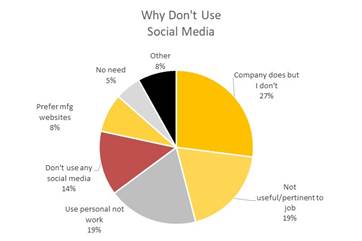 Why Don’t Construction Professionals Use Social Media?
Why Don’t Construction Professionals Use Social Media?
Even with the surge of social media use, there is still some resistance to utilize social media for business. Interestingly, the AIM study found that the use of social media all boils down to whether it is pertinent to their jobs: 27% of those who do not use social media indicated their company uses it, but they do not. In addition, many (19%) indicated they did not find social media useful or pertinent to their job. Open-ended comments indicated there are many reasons professionals don’t use social media for work—sometimes it is time consuming and the benefits don’t outweigh the time spent.
Some of the respondents explained it this way:
- I do not use these sites because they do not entail communication with my professional network. Additionally, professional software for my line of work does not interface well with social media.
- I find the time spent to stay fully active on social media sites outweighs the benefits.
- This information is available on the web. Social media is distracting and not allowed during work hours.
- Feel that they are unsecured and do not wish to share information with the world.
Interestingly, the research also found that while the personal use of social media by building professionals remained high, there is some variance of use for work depending on their years working in the industry. For example, only 47% building professionals with five years or less on the job use social media for work. Whereas it jumps to 73% for those on the job six to ten years and over 80% for 11 years and up.
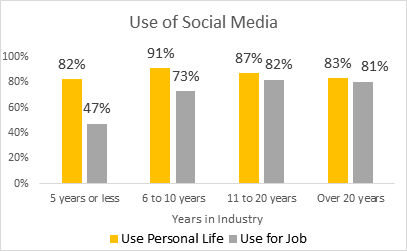 The results seem to indicate that industry veterans will use social media for business more than those starting out and are perhaps of a younger generation. This seems to go against common assumptions that younger generations more actively use social media for everything: their personal use remains high, but they lag behind with professional use.
The results seem to indicate that industry veterans will use social media for business more than those starting out and are perhaps of a younger generation. This seems to go against common assumptions that younger generations more actively use social media for everything: their personal use remains high, but they lag behind with professional use.
A recent article posted by Forbes[4] indicates that research conducted by Attest indicates that as age goes up the percent of population using social media goes down. In fact, generation Z is definitely using social media more than baby boomers or “other” older age groups. The article goes on to indicate the type of social media they use also changes with age, where 69% of Gen Z uses TikTok a relatively new social media verses babyboomers and Gen X who are heavier users of Facebook[5].
But, most articles published on social media use are about one’s personal use. AIM’s research shows professionals use for their personal life compared to their use for their job. AIM’s research indicates that the majority (80%+) of professionals’ use social media in their personal life regardless of how long they been in the industry. Perhaps the reason those on their job five years or less use social media less for their job is because their particular job function does not require the use of social media. Whereas, seasoned professionals may be in jobs that require them to actively promote and market their company and need to be active in social media.
It’s a Shot in the Dark— Knowing How Professionals Use Social Media
To communicate with building professional on social media, you need to first understand how they use it for their job. In order to engage with building professionals it is essitial to know what they use and where they look for information on these channels. Otherwise you may as well be shooting in the dark.
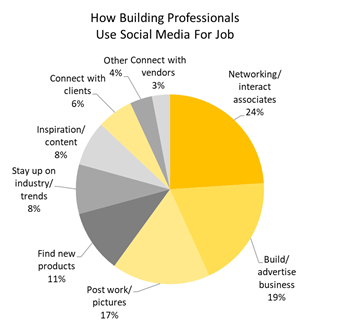 There are a number of reasons that building professionals use social media and online channels for their jobs. In an open-ended question, AIM asked building professionals to tell us how they are using social media for their jobs. Putting the comments into categories, AIM’s research revealed they use social media for a variety of reasons. The obvious reasons point to networking and interacting with associates (24%), building their businesses (19%) and finding new products (11%) or industry news (8%).
There are a number of reasons that building professionals use social media and online channels for their jobs. In an open-ended question, AIM asked building professionals to tell us how they are using social media for their jobs. Putting the comments into categories, AIM’s research revealed they use social media for a variety of reasons. The obvious reasons point to networking and interacting with associates (24%), building their businesses (19%) and finding new products (11%) or industry news (8%).
But, that’s not the full picture. Another way to look at it, their usage can be divided into three categories (almost equally):
- Interacting or connecting with others (associates, vendors and clients) (33%)
- Collecting information on products and trends (31%)
- Informing about their business (36%).
Sample of professionals’ open-ended comments below can help manufacturers get a better understanding on how professionals are using social media in their jobs.
- Promote my business and connect with colleagues and see pictures of products/designs.
- To get the message out as to what we are doing, we regularly post project information on our
Facebook site as well as LinkedIn. These have led to marketing opportunities.
- I use it to connect with vendors and keep up with new products and inspiring imagery.
- A good way to reach potential clients who don’t already know you or your business.
- A good way to reach potential clients who don’t already know you or your business.
- Facebook site as well as LinkedIn. These have led to marketing opportunities.
Other research presented by an architecture group, Rethinking The Future[6] confirms AIM’s research that many architects are using social media for a variety of reasons. The article highlights how architects are successfully using social media to build their business, reach and communicate with clients and vendors or to interact with other professionals involved with the building construction industry.
This is important information for any product manufacturer who is interested in building relationships with professionals in the design, construction, and facility management areas. More and more these professionals are using social media to communicate and to look for products and solutions for their projects.
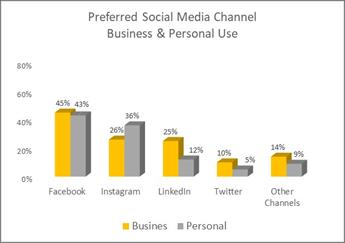 Using the Right Channels?
Using the Right Channels?
So, where are these interactions taking place and which platforms do construction and design professionals tend to use? Even with the social media explosion during the pandemic, AIM research indicates that more professionals were using Facebook than other channels for both professional and personal use.
While it may be no surprise that Facebook is used for both business and personal use, the AIM research revealed Instagram is used more for personal use than for business use. Furthermore, professionals also use LinkedIn and Twitter for business more often than for personal use. But, this is changing as more and more professionals are using social media for their jobs and to stay connected to others in their industry.
In fact, the use of a particular social media channel may also vary based on the type of company or business and/or a professional’s particular job function. In an article by builderspace.com,[7] The Seven Best Media Platforms for Construction Companies, they recommend Twitter as the top platform to use for construction companies followed by LinkedIn. While the article goes on to say Facebook is number three, they say it is still the biggest social media channel in the world. While research can provide insight on which channels building professionals are using, the “popularity” of use can vary depending on the type of professional and the type of company they work for.
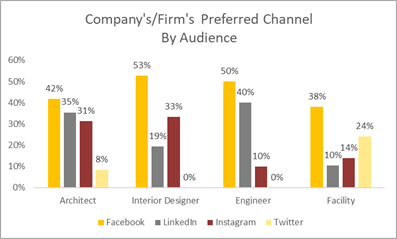 A closer look reveals that even though Facebook might still be dominant with companies/firms in the building construction industry, the use of top three preferred channels can vary.
A closer look reveals that even though Facebook might still be dominant with companies/firms in the building construction industry, the use of top three preferred channels can vary.
For example, the AIM research indicates that while architectural and engineering firms are more likely to use Facebook or LinkedIn most often, Interior Designer companies will use Facebook or Instagram most often. Interestingly, Twitter is used more by facility management professionals more than any other type of professional.
It is important to keep in mind that the use of social media is rapidly changing and with COVID-19, more and more professionals are using social media to stay connected and to communicate when they can’t physically visit with vendors, clients or other professionals. While many professionals use more than one platform, the frequency of use can change.
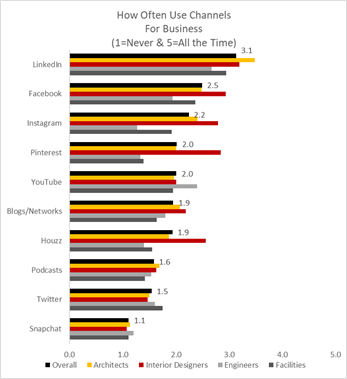 While AIM’s research shows more professionals use Facebook than other channels, it is important to look at how often professionals are using various platforms for business use. In fact, AIM’s research on frequency of use of various social media channels by type of professional shows that when it comes to frequency of use, LinkedIn rises to the top followed by Facebook and Instagram. The research also indicates there are other social media channels that professionals are using for their job—channels like Pinterest, Houzz and YouTube. Many of these are more focused on design industry that may be of more interest to building professionals for keeping up on the industry.
While AIM’s research shows more professionals use Facebook than other channels, it is important to look at how often professionals are using various platforms for business use. In fact, AIM’s research on frequency of use of various social media channels by type of professional shows that when it comes to frequency of use, LinkedIn rises to the top followed by Facebook and Instagram. The research also indicates there are other social media channels that professionals are using for their job—channels like Pinterest, Houzz and YouTube. Many of these are more focused on design industry that may be of more interest to building professionals for keeping up on the industry.
The preference for a specific channel within social media is not that simple. The AIM research shows that the frequency of use can also vary by type of professional. Interior designers, for example, are more active than other professionals in many of the social media platforms studied. They are heavy users of Pinterest, Houzz and Instagram. In comparison, engineers are more active on YouTube than other professions and architects are more frequently using LinkedIn.
It won’t be easy for product manufacturers to determine where they should focus their marketing and communications efforts within the social media platform. It will depend on the product they are promoting, who they are trying to reach and what message they are trying to send. In today’s environment the best way to know for sure which channels work for a particular company is to try all social media channels and see what works and what doesn’t.
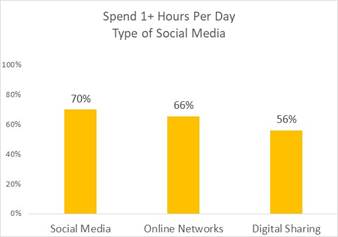 AIM’s research indicates the 70% of professionals spend an hour or more on social media for business. In addition, over 50% are also using online networks and digital sharing sites as well. Since most professionals are using social media today for their job and many with frequency, it is important for manufacturers to be there too.
AIM’s research indicates the 70% of professionals spend an hour or more on social media for business. In addition, over 50% are also using online networks and digital sharing sites as well. Since most professionals are using social media today for their job and many with frequency, it is important for manufacturers to be there too.
Social media is changing — that’s a fact
Social media is constantly changing. This year alone, the global pandemic and technological changes have led to an online world that is quite different from even two years ago. Yet, if you know how professionals use social media for work and where they tend to spend their time, you know where to at least start. It can be overwhelming and challenging for businesses to keep up with the trends in social media. But, these challenges can be overcome.
As confirmed by this study conducted during the height of the pandemic, although use and preferences within social media are constantly shifting, it is still a critical part of the way professionals communicate and a key part of how work gets done. Also, the use of these social media channels became even more critical during the pandemic. It remains important to know how professionals use these technologies and for what purposes. Today, more than ever, they help expand your network by finding and connecting with relevant professionals in your industry.
Armed with the knowledge of how professionals use social media, the AIM research provides the foundation to create a definitive path to connecting in social media professional purposes. When trying to reach building professionals with products or services, it is important to be active in the social media platforms the targeted audience uses most often.
Stay tuned–Part 2 of AIM’s social media research will continue the social media journey by covering more on what this means to manufacturers and the future use of social media. Part 2 will provide more details on what companies can do to maximize their company’s use of social media and how to make sure the social media content they provide is reliable and more effective in reaching their target audience.
_________________
[1]DataReportalhttps://datareportal.com/social-media-users
[2]https://www.rainsalestraining.com/resources/sales-white-papers/virtual-selling-skills-challenges
[3] Architect magazine, “The Architecture of Social Media”, December 2021;https://www.architectmagazine.com/technology/the-architecture-of-social-media_o
[4] Forbes, Media Habits Are Changing Rapidly For Young Adults, Making Ad Targeting More Challenging, October, 2021,https://www.forbes.com/sites/bradadgate/2021/10/07/media-habits-are-changing-rapidly-for-young-adults-making-targeting-more-challenging/?sh=7c6a329e3303
[5] Least we not forget, Facebook CEO Mark Zuckerberg announced on October. 28 that Facebook is changing its name. What was formerly known as Facebook Inc., the parent company behind the namesake app, as well as Instagram, WhatsApp, Messenger, and the virtual reality company Oculus is now called Meta Platforms Inc. How many people are aware of that? Moreover, how does it affect the future use of the channel itself?
[6] Rethinking the Future, How Has Social Media Become a Powerful Toll for Architects. https://www.re-thinkingthefuture.com/architectural-community/a4174-how-has-social-media-become-a-powerful-tool-for-architects/
[7] Builderspace.com, The Seven Best Media Platforms for Construction Companies, https://www.builderspace.com/best-social-media-platforms-for-construction-companies